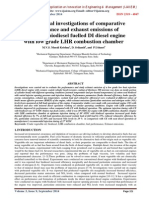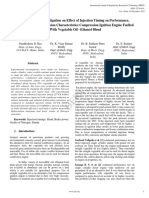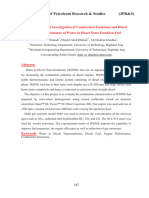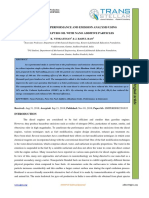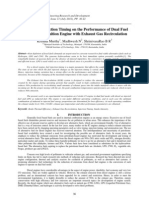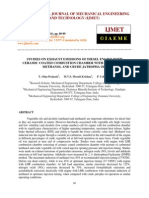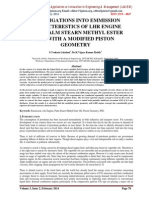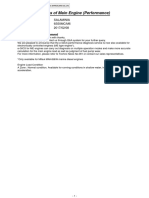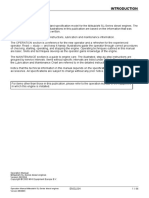IJERD (www.ijerd.com) International Journal of Engineering Research and Development IJERD : hard copy of journal, Call for Papers 2012, publishing of journal, journal of science and technology, research paper publishing, where to publish research paper, journal publishing, how to publish research paper, Call For research paper, international journal, publishing a paper, how to get a research paper published, publishing a paper, publishing of research paper, reserach and review articles, IJERD Journal, How to publish your research paper, publish research paper, open access engineering journal, Engineering journal, Mathemetics journal, Physics journal, Chemistry journal, Computer Engineering, how to submit your paper, peer review journal, indexed journal, reserach and review articles, engineering journal, www.ijerd.com, research journals, yahoo journals, bing journals, International Journal of Engineering Research and Development, google journals, journal of engineering, online Submis
IJERD (www.ijerd.com) International Journal of Engineering Research and Development IJERD : hard copy of journal, Call for Papers 2012, publishing of journal, journal of science and technology, research paper publishing, where to publish research paper, journal publishing, how to publish research paper, Call For research paper, international journal, publishing a paper, how to get a research paper published, publishing a paper, publishing of research paper, reserach and review articles, IJERD Journal, How to publish your research paper, publish research paper, open access engineering journal, Engineering journal, Mathemetics journal, Physics journal, Chemistry journal, Computer Engineering, how to submit your paper, peer review journal, indexed journal, reserach and review articles, engineering journal, www.ijerd.com, research journals, yahoo journals, bing journals, International Journal of Engineering Research and Development, google journals, journal of engineering, online Submis
Uploaded by
IJERDCopyright:
Available Formats
IJERD (www.ijerd.com) International Journal of Engineering Research and Development IJERD : hard copy of journal, Call for Papers 2012, publishing of journal, journal of science and technology, research paper publishing, where to publish research paper, journal publishing, how to publish research paper, Call For research paper, international journal, publishing a paper, how to get a research paper published, publishing a paper, publishing of research paper, reserach and review articles, IJERD Journal, How to publish your research paper, publish research paper, open access engineering journal, Engineering journal, Mathemetics journal, Physics journal, Chemistry journal, Computer Engineering, how to submit your paper, peer review journal, indexed journal, reserach and review articles, engineering journal, www.ijerd.com, research journals, yahoo journals, bing journals, International Journal of Engineering Research and Development, google journals, journal of engineering, online Submis
IJERD (www.ijerd.com) International Journal of Engineering Research and Development IJERD : hard copy of journal, Call for Papers 2012, publishing of journal, journal of science and technology, research paper publishing, where to publish research paper, journal publishing, how to publish research paper, Call For research paper, international journal, publishing a paper, how to get a research paper published, publishing a paper, publishing of research paper, reserach and review articles, IJERD Journal, How to publish your research paper, publish research paper, open access engineering journal, Engineering journal, Mathemetics journal, Physics journal, Chemistry journal, Computer Engineering, how to submit your paper, peer review journal, indexed journal, reserach and review articles, engineering journal, www.ijerd.com, research journals, yahoo journals, bing journals, International Journal of Engineering Research and Development, google journals, journal of engineering, online Submis
Uploaded by
IJERDCopyright
Available Formats
Share this document
Did you find this document useful?
Is this content inappropriate?
Copyright:
Available Formats
IJERD (www.ijerd.com) International Journal of Engineering Research and Development IJERD : hard copy of journal, Call for Papers 2012, publishing of journal, journal of science and technology, research paper publishing, where to publish research paper, journal publishing, how to publish research paper, Call For research paper, international journal, publishing a paper, how to get a research paper published, publishing a paper, publishing of research paper, reserach and review articles, IJERD Journal, How to publish your research paper, publish research paper, open access engineering journal, Engineering journal, Mathemetics journal, Physics journal, Chemistry journal, Computer Engineering, how to submit your paper, peer review journal, indexed journal, reserach and review articles, engineering journal, www.ijerd.com, research journals, yahoo journals, bing journals, International Journal of Engineering Research and Development, google journals, journal of engineering, online Submis
IJERD (www.ijerd.com) International Journal of Engineering Research and Development IJERD : hard copy of journal, Call for Papers 2012, publishing of journal, journal of science and technology, research paper publishing, where to publish research paper, journal publishing, how to publish research paper, Call For research paper, international journal, publishing a paper, how to get a research paper published, publishing a paper, publishing of research paper, reserach and review articles, IJERD Journal, How to publish your research paper, publish research paper, open access engineering journal, Engineering journal, Mathemetics journal, Physics journal, Chemistry journal, Computer Engineering, how to submit your paper, peer review journal, indexed journal, reserach and review articles, engineering journal, www.ijerd.com, research journals, yahoo journals, bing journals, International Journal of Engineering Research and Development, google journals, journal of engineering, online Submis
Uploaded by
IJERDCopyright:
Available Formats
International Journal of Engineering Research and Development e-ISSN: 2278-067X, p-ISSN: 2278-800X, www.ijerd.
com Volume 3, Issue 2 (August 2012), PP. 12-20
Comparative Experimental Investigation of Combustion, Performance and Emission in a Single Cylinder Thermal Barrier Coated Diesel Engine using Diesel and Neem Biodiesel
M C Navindgi1, Dr. Maheswar Dutta2, Dr. B. Sudheer Prem Kumar3
1
Associate Professor, Department of Mechanical Engineering, PDA College of Engineering, Gulbarga, Karntaka, India, 2 Principal, MNR College of Engineering & Technology, Sangareddy, Medak District, AP, India 3 Professor, Department of Mechanical Engineering, JNTU Hyderabad, A.P, India
Abstract- The use of methyl esters of vegetable oil known as biodiesel are increasingly popular because of their low impact on environment, green alternate fuel and most interestingly it's use in engines does not require major modification in the engine hardware. Use of biodiesel as sole fuel in conventional direct injection diesel engine results in combustion problems, hence it is proposed to use the biodiesel in low heat rejection (LHR) diesel engines with its significance characteristics of higher operating temperature, maximum heat release, higher brake thermal efficiency (BTE) and ability to handle the lower calorific value (CV) fuel. In this work biodiesel from Neem oil called as Neem oil methyl ester (NOME) was used as sole fuel in conventional diesel engine and LHR direct injection (Dl) diesel engine. The low heat rejection engine was developed with uniform ceramic coating of combustion chamber (includes piston crown, cylinder head, valves and cylinder liner) by partially stabilized /zirconia (PSZ) of 0.5 mm thickness. The experimental investigation was carried out in a single cylinder water-cooled LHR direct injection diesel engine. In this investigation, the combustion, performance and emission analysis were carried out in a diesel and biodiesel fueled conventional and LHR engine under identical operating conditions. The test result of biodiesel fueled LHR engine was quite identical to that of the conventional diesel engine. The brake thermal efficiency (BTE) of LHR engine with biodiesel is decreased marginally than LHR engine operated with diesel. Carbon monoxide (CO) and Hydrocarbon (HC) emission levels are decreased. The results of this comparative experimental investigation reveals that, some of the drawbacks of biodiesel could be made as advantageous factors while using it as a fuel in the LHR diesel engine. In the final analysis, it was found that, the results are quite satisfactory. Keywords: LHR Engine, Biodiesel, Neem oil, Emission Characteristics, Thermal coating
I.
INTRODUCTION
Diesel engines are the dominating one primarily in the field of transportation and secondarily in agricultural machinery due to its superior fuel economy and higher fuel efficiency. The world survey explicit that the diesel fuel consumption is several times higher than that of gasoline fuel. These fuels are fossil in nature, leads to the depletion of fuel and increasing cost. It has been found that the chemically treated vegetable oil often called as biodiesel is a promising fuel, because of their properties are similar to that of diesel fuel (DF) and it is a renewable and can be easily produced. Compared to the conventional Dl diesel engine the basic concept of LHR engine is to suppress the heat rejection to the coolant so that the useful power output can be increased, which in turn results in improved thermal efficiency. However previous studies are revealing that the thermal efficiency variation of LHR engine not only depends on the heat recovery system, but also depends on the engine configuration, operating condition and physical properties of the insulation material (1-2). The drawback of an LHR engine has to be considered seriously and effort has to be taken to reduce the increased heat loss wi t h the exhaust and increased level of NOx emission. The potential techniques available for the reduction of NOx from diesel engines are exhaust gas recirculation (EGR), water injection, slower burn rate, reduced intake air temperature and particularly retarding the injection timing (3). It is strongly proven that the increasing thickness of ceramic coatings arrest the heat loss from the engine cylinder, in contrast decreases the power and torque. The optimized coating thickness can be identified through the simulation techniques (4). One of the viable significance of LHR engine is ut ilizing the low calorific value fuel such as biodiesel. Studies have revealed that, the use of biodiesel under identical condition as that for the diesel fuel results in slightly lower performance and emission levels due to the mismatching of the fuel properties mainly low calorific value and higher viscosity. The problems associated with the higher viscosity of biodiesel in a compression ignition (CI) engines are pumping loss, gum formation, injector nozzle coking, ring sticking and incompatibility with lubricating oil (5-8). The above identified problems with the use of biodiesel in conventional diesel engine can be reduced in L H R engines except for the injection problem. The present investigation involves the comparison of combustion, performance and emission levels of diesel and biodiesel (Neem based) in conventional and LHR DI diesel engines.
II.
FUEL PREPARATIONS AND CHARACTERIZATION
The vegetable oil was transesterified-using methanol in the presence of NaOH as a catalyst. The parameter involved in the above processing includes the catalyst amount, molar ratio of alcohol to oil, reaction temperature and reaction time (9-11). The parameters for the biodiesel production are optimized such as Catalyst amount, Molar ratio (Alcohol to Oil),
12
Comparative Experimental Investigation of Combustion, Performance and Emission in a Single
Reaction temperature, and Reaction time. The raw biodiesel obtained was brought down pH to a value of 7. This pure biodiesel was measured on weight basis and the important physical and chemical properties were determined as per the BIS standards (10). It is evident that, the dilution of blending of vegetable oil with other fuels like alcohol or diesel would bring the viscosity close to the specification range for a diesel engine (11-13). The important physical and chemical properties of the biodiesel thus prepared are given in table 1. Table 1 Properties of the diesel and biodiesel fuel Characteristics Diesel Fuel B100 Density @ 15C (kg/m3) 837 0.890 Viscosity @ 40C (cSt) 3.2 5.7 Flash point (C) 65 152 Cetane number 47 52 Calorific Value (MJ/kg) 42 37.2
III.
DEVELOPMENT OF TEST ENGINE
The engine combustion chamber was coated with partially stabilized zirconia (PSZ) of 0.5 mm thickness, which includes the piston crown, cylinder head, valves, and outside of the cylinder liner. The equal amount of material has been removed from the various parts of the combustion chamber and PSZ was coated uniformly. After PSZ coating, the engine was allowed to run about 10 hours, then test were conducted on it.
Fig.1 Photograph of PSZ coated piston, Cylinder Head and Valves
IV.
EXPERIMENTAL PROCEDURE
The experimental setup and the specification of the test engine are shown in Fig.2 and Table 2 respectively. The engine was coupled with an eddy current dynamometer for performance and emission testing. A piezoelectric transducer was mounted through an adopter in the cylinder head to measure the in-cylinder pressure. Signal from the pressure transducer was fed to charge amplifier. A magnetic shaft encoder was used to measure the TDC and crank angle position. The signals from the charge amplifier and shaft encoder were given to the appropriate channels of a data acquisition system.
Fig 2: Experimental Test Rig. Nomenclature: PT Pressure transducer T1 Jacket water inlet temp. T2 Jacket water outlet temp. T3 Calorimeter water inlet temp. T4 Calorimeter water outlet temp.
13
Comparative Experimental Investigation of Combustion, Performance and Emission in a Single
T5 T6 N EGA SM Exh gas to calorimeter temp. Exh gas from calorimeter temp. Rotary encoder Exh Gas Analyzer Smoke Meter
The analyzer used to measure the engine exhaust emission was calibrated before each test. Using the appropriate calibration curve, the measurement error for each analyzer was reduced as per the recommendation by the exhaust analyzer manual. Diesel and biodiesel was used in the conventional diesel engine and the PSZ coated LHR engine. Cylinder pressure data was recorded and the other desired datas were processed. The experiments were carried out in a single cylinder, naturally aspirated, constant speed, and water-cooled direct injection diesel engine with the following specifications. Table 2 Specification of test engine __ __ Manufacturer Kirloskar Engines Ltd., India Model TVSR II, naturally aspirated Engine Single cylinder, DI Bore/stroke 87.5mm/110mm Compression ratio 17.5:1 Speed 1500 r/min, constant Rated power 5.2kW Working cycle Four stroke Injection pressure 240 bar/23 deg TDC Type of sensor Piezo electric Response time 4 micro seconds Technical features of Smoke meter: Make & Model: Neptune Equipments, India, Smoke sampling : Partial flow Zeroing : Automatic
The test procedure was adopted from Beareu of Indian Standards BIS-10000 (year 1985).
V.
COMBUSTION AND HEAT RELEASE ANALYSIS
The combustion parameters can be studied through the analysis of heat release rate obtained from the pressure crank angle diagram. It is assumed that the mixture is homogeneous and uniform pressure and temperature at each instant of time during the combustion process. The heat release rate can be calculated from the first law of thermodynamics.
(1)
Where
- Heat transfer rate,
- Work done by the system - mass of flow into the system - Enthalpy of flow into the system - Pressure at any crank angle V - Volume at any crank angle U - Internal energy at any crank angle By neglecting the crevice volume and its effect, the equation (1) is reduced to
(2)
Where - fuel flow rate - Enthalpy of the fuel This equation (2) can be further reduced to
= Where
(3)
14
Comparative Experimental Investigation of Combustion, Performance and Emission in a Single
- Net heat release rate - Gross heat release
- Heat transfer rate to the wall From the ideal gas equation PV=mRT this equation (3) is further modified in to
1 1
(4)
The pressure at any angle obtained form the pressure crank angle diagram makes it possible to find out the heat release at any crank angle.
VI.
A. Cylinder Pressure
RESULTS AND DISCUSSIONS
Fig. 3 Variation of cylinder pressure with respect to crank angle at full load In a CI engine the cylinder pressure is depends on the fuel-burning rate during the premixed burning phase, which in turn leads better combustion and heal release. Figure 3 shows the typical variation of cylinder pressure with respect to crank angle. The cylinder pressure in the case of biodiesel fueled LHR engine is about 4.7 % lesser than the diesel fueled LHR engine and higher by about 1.64 % and 12.22% than conventional engine fueled wi t h diesel and biodiesel. This reduction in the in c yl ind e r pressure may be due to lower calorific value and slower combustion rates associated with biodiesel fueled LHR engine. However the cylinder pressure is relatively higher than the diesel engine fueled with diesel and biodiesel. It is noted that the maximum pressure obtained for LHR engine fueled with biodiesel was closer with TDC around 2 degree crank angle than LHR engine fueled with diesel. The fuel-burning rate in the early stage of combustion is higher in the case of biodiesel than the diesel fuel, which bring the peak pressure more closely to TDC. B. Heat Release Rate
Fig. 4 Variation of heat release rate with respect to crank angle at full load Figure 4 shows the variation of heat release rate with respect to crank angle. It is evident from the graph that, diesel and biodiesel fuel experiences the rapid premixed combustion followed by diffusion combustion. The premixed fuel burns rapidly and releases the maximum amount heat followed by the controlled heat release. The heat release rate during the premixed combustion is responsible for the cylinder peak pressure. The maximum heat release of LHR engine with biodiesel is lower about 6.67% than LHR engine fueled with diesel and higher about 3.15% and 10.1% respectively than conventional engine fueled with diesel and biodiesel. It was found that, premixed combustion in the case of biodiesel fuel starts earlier than the diesel fuel and it may be du e to excess oxygen available along with higher operating temperature in the fuel and the consequent reduction in delay period than that of diesel fuel. It may be expected that high surrounding temperature and oxygen availability of fuel itself (biodiesel) reduce the delay
15
Comparative Experimental Investigation of Combustion, Performance and Emission in a Single
period. However higher molecular weight lower calorific value and slightly higher value of viscosity bring down the peak heat release during the premixed combustion period. The heat release is well advanced due to the shorter delay period and early burning of the biodiesel. It is found that, the heat release rate of biodiesel, normally accumulated during the delay period follows the similar trends like diesel fuel. C. Cumulative Heat Release Rate Figure 5 shows the variation of cumulative heat release with respect to crank angle. In general, the availability of oxygen in the biodiesel fuel itself enhances the combustion and thus increases the net heat release. In this investigation at full load, the net heat release for LHR engine fueled with biodiesel is lower by about 8.89% than LHR engine fueled with diesel and higher by about 1.86% and 4.49% respectively than conventional diesel engine fueled with diesel and biodiesel.
Fig.5 Variation of cumulative heat release with respect lo crank angle at full load D. Brake Thermal Efficiency Figure 6 shows the variation of brake thermal efficiency with engine power output. The maximum efficiency obtained in the case of LHR engine fueled with biodiesel at full load was lower by about 2.87% than LHR engine fueled with diesel and higher by about 4.81% and 14.9% respectively than conventional diesel engine fueled with diesel and biodiesel. In overall, it is evident that, the thermal efficiency obtained in the ease of LHR engine fueled with biodiesel is substantially good enough within the power output range of the test engine.
Fig. 6 Variation of brake thermal efficiency with engine power output E. Specific fuel Consumption The variations of brake specific fuel consumption (SFC) with engine power output for different fuels are presented in figure 7. At maximum load the specific fuel consumption of LHR engine fueled with biodiesel is higher by about 5.24% than LHR engine fueled with diesel and lower by about 4.51% and 13.8% respectively than conventional engine fueled with diesel and biodiesel. This higher fuel consumption was due to the combined effect of lower calorific value and high density of biodiesel. The test engine consumed additional biodiesel fuel in order to retain the same power output.
16
Comparative Experimental Investigation of Combustion, Performance and Emission in a Single
Fig. 7 Variation of Specific fuel consumption with engine power output F. Specific Energy Consumption Figure 8 shows the variation between specific energy consumption (SEC) and engine power output. The heat input required to produce unit quantity of power is proportionately varying with SFC. Higher the energy required at low load and decreases by increasing the load. It is found that the specific energy consumption of LHR engine with biodiesel is higher by about 6.44% than the LHR engine with diesel fuel and lowers by about 5.05% and 11.25% respectively for conventional diesel engine with diesel and biodiesel.
Fig.8 Variation of specific energy consumption with engine power output G. Exhaust Gas Temperature Figure 9 shows the variation of exhaust gas temperature with engine power output. At full load, the exhaust gas temperature of LHR engine fueled with biodiesel gives lower value by about 1.37% than LHR engine fueled with diesel and higher by about 3.70% and 6.24% respectively than conventional engine with diesel and biodiesel. The higher operating temperature of LHR engine is responsible for the higher exhaust temperature. The exhaust gas temperature of biodiesel varies proportionately with engine power output as in the case of diesel fuel. It may be due to the heat release rate by the biodiesel during the expansion is comparatively lower than diesel.
Fig.9 Variation of exhaust gas temperature with engine power output H. Carbon Monoxide The variation of carbon monoxide (CO) with engine power output is presented in figure 10. The fuels are producing
17
Comparative Experimental Investigation of Combustion, Performance and Emission in a Single
higher amount of carbon monoxide emission at low power outputs and giving lower values at higher power conditions. Carbon monoxide emission decreases with increasing power output. At full load, CO emission for LHR engine with biodiesel fuel is lower by about 6.82%, 56.1% and 31.70% respectively than LHR engine with diesel, conventional engine fueled with biodiesel and diesel. With increasing biodiesel percentage, CO emission level decreases. Biodiesel itself has about 11 % oxygen content in it and it may helps for the complete combustion. Hence, CO emission level decreases with increasing biodiesel percentage in the fuel.
Fig. 10 Variation or carbon monoxide with engine power output I. Unburned Hydrocarbon The variation of hydrocarbon (HC) with respect to engine power output for different fuels are shown in figure l1.The high operating temperature in LHR engine makes the combustion nearly complete than the limited operating temperature condition as in the case of diesel engine. Al full load hydrocarbon emission levels are decreases for LHR engine fueled with biodiesel than LHR engine fueled with diesel and diesel engine fueled with diesel and biodiesel such as 0.14%, 21.69%and 13% respectively. The air fuel mixture, which was accumulated in the crevice volume, was reduced due to the high temperature and availability of oxygen, which in turn leads to reduction in unburned hydrocarbon emissions.
Fig. 11 Variation of hydrocarbon with engine power output
VII.
CONCLUSION
The biodiesel produced from Neem oil by transesierification process reduces the viscosity of the oil in order to match the suitability of diesel fuel. The diesel engine is modified in to LHR engine by means of partially stabilized zirconia (PSZ) coating. The various combustion parameters such as cylinder pressure, rate of heat release, cumulative heat releases were analyzed and the following conclusions were drawn. i. At full load condition, the cylinder pressure in the case of biodiesel fueled LHR engine was lower than that of the diesel fueled LHR engine. Even though (his reduction under identical condition is substantial. The absolute value of this cylinder peak pressure is well within operating limits of the test engine. ii. The final analysis of the heal release shows that the value of net heat release in the case of biodiesel fueled LHR engine is substantially good enough for the effective work done of the lest engine. The performance characteristics such as brake thermal efficiency, specific fuel consumption and specific energy consumption and various emission characteristics were compared and summarized as follows. i. The maximum efficiency obtained in the case of LHR engine fueled with biodiesel was lower than the LHR engine operated with diesel fuel. However the efficiency of the LHR engine with biodiesel fuel is well within the expected limits, ii. The exhaust gas temperature of LHR engine fueled with biodiesel was lower than LHR engine fueled with diesel throughout the operating condition. The low exhaust gas temperature indicates the heat release rate during the late
18
Comparative Experimental Investigation of Combustion, Performance and Emission in a Single
combustion was comparatively lower than diesel fuel. iii. The specific fuel consumption of LHR engine with biodiesel was higher than LHR engine fueled with diesel. The higher consumption of fuel due to low calorific value and high viscosity. Even though it could be expected to the offset by the cost of biodiesel. iv. The specific energy consumption of LHR engine with biodiesel was higher than LHR engine fueled with diesel fuel. v. It was found that, CO and HC emissions for LHR engine with biodiesel was considerably lower than LHR engine fueled with diesel. This reduction of emissions due to excess oxygen availability along with higher operating temperature. The above comparative study clearly reveals the possibility of using the biodiesel in LHR direct injection diesel engine. The combustion, performance and emission characteristics show the suitability of biodiesel in LHR engine.
REFERENCES
[1]. [2]. [3]. [4]. [5]. [6]. [7]. [8]. [9]. [10].
[11]. [12]. [13]. [14].
[15].
[16].
[17]. [18]. [19].
[20]. [21]. [22].
[23]. [24].
Woschni 0. Spindler W. Kolesa K," Heat insulation of combustion chamber wallsa measure to decrease the fuel combustion of l.C. engines", SAE paper No.850359. Kamo R, Mavinahally NS, Kamo L, Bryzik W, Sdiwartz E." Injection characteristics that improve performance of ceramics coated diesel engines", SAE paper No. 1999-01-0972. Aman CA," Promises and challenges of the low-heat-rejection diesel Engine". J Eng Gas Turb Power 1988; 110:475-81. P.Tamil Porai, "Simulation and Analysis of combustion and heat transfer in low heat rejection diesel engine using two zone combustion model and different heat transfer models". Ph.D Thesis, Anna University, Feb 1998. Pryde E H," Vegelable oil as diesel fuels; overview. Papers from the symposium on vegetable oils as diesel fuels". Presented at the 73rd AOCS annual meeting, Toronto, Canada. J. Am. Oil Chem. Soc. 1983; 60(8). Ryan T W. Dodge L G. Callahan T J," The effects of vegetable oil properties on injection and combustion in two different diesel engines." J. Am. Oil Chem. Soc. 1984; 61(10); 1610-9. Ziejewski M. Kaufman K R." Laboratory endurance test of sunflower oil blend in a diesel engine", J, Am. Oil Chem. Soc. 1983:60(8); 1567-73. Korus R A, Jaiduk J, Pcterson C L," A rapid engine test to measure injector fouling in diesel engines using vegetable oil fuels", J. Am. Oil Chem. Soc. 1985:62(11): 1563-4. Fangrui Maa, Milford A Hannab;" Biodiesel production: a review, Bioresource Technology, 70(1999) 1-15. Hanumanth Mulimani, O D Hebbal, M. C. Navindgi, " Extraction of Biodiesel from Vegetable Oils and their comparisons ", International Journal of Advanced Scientific Research and Technology (IJST) Issue 2, Volume 2 (April 2012) pp 242-250 L.C. Meher a, Vidya S.S. Dharmagadda b, S.N. Naik a, ''Optimization of alkali-catalyzed transesteriW cation of Pongamia pinnata oil for production of Biodiesel ", Bioresource Technology, 97(2006)1392-1397 Agarwal A K, '"Vegetable oils verses diesel fuel; development and use of biodiesel in a compression ignition engine", TIDE 1998:8(3): 191-204. Sinha S, Misra NC," Diesel fuel alternative from vegetable oils", Chem. Engg World 1997: 32(10): 77-80. B.Rajendra Prasath, P.Tamil Porai, Mohd. P. Shair "Theoretical Modeling and Experimental Study of Combustion and Performance Characteristics of Biodiesel in Turbocharged Low Heat Rejection D.I Diesel Engine", World Academy of Science, Engineering and Technology 61 2010. B.Rajendra Prasath, P.Tamil Porai, Mohd. F. Shair "Simulation and Analysis of Combustion, Performance and Emission Characteristics of Biodiesel Fueled Low Heat Rejection Direct Injection Diesel Engine", SAE Paper No. 2007-32-0094. Mohd. E. Shair, P.Tamil Porai. B.Rajendra Prasath Analysis of Combustion, Performance and Emission Characteristics of Turbocharged LHR Extended Expansion DI Diesel Engine" World Academy of Science, Engineering and Technology 61 2010. Mohd. F. Shair, P.Tamil Porai, B.Rajendra Prasath, Analysis of expanded cycle and internal EGR for LHR Dl diesel engines. Journal of future Engineering and Technology, Vol.5, No.2. pp.32-41. Hanbey Hazar, Effects of bio-diesel on a low heat loss diesel engine, Renewable Energy, No. 34, pp. 15331537, 2009. Banapurmath, N. R. and Tewari, P. G., Performance studies of a low heat rejection engine operated on non-volatile vegetable oils with exhaust gas recirculation, International Journal of Sustainable Engineering, 2(4), pp. 265-274, 2009. Parker, D.A. and Dennison, G.M., Development of an air gap insulated piston, SAE Paper No-870652, 1987. Rama Mohan, K., Vara Prasad, C.M. and Murali Krishna, M.V.S.,Performance of a low heat rejection diesel engine with air gap insulated piston, ASME Journal of Engineering for Gas Turbinesand Power, 121,pp. 530-540, 1999. Jabez Dhinagar, S., Nagalingam, B. and Gopala Krishnan, K.V. A comparative study of the performance of a low heat rejection engine with four different levels of insulation, Proceedings of IV International Conference on Small Engines and Fuels, pp.121-126, Chang Mai, Thailand, 1993. Murali Krishna, M.V.S., Performance evaluation of low heat rejection diesel engine with alternate fuels, Ph.D Thesis, J.N.T.University, Hyderaba, 2004. Krishna Murthy, P.V., Studies on bio-diesel on low heat rejection diesel engine, Ph.D Thesis, J.N.T. University, Hyderabad, 2010.
19
Comparative Experimental Investigation of Combustion, Performance and Emission in a Single
Nomenclature LHRE BDF DE DF DI PSZ CV CO HC LHR SEC SFC TDC BTDC BIS U Q m h p V t T Cv
Low heat rejection engine Biodiesel fuel Diesel engine Diesel fuel Direct injection Partially stabilized zirconia Calorific value, MJ/kg Carbon monoxide, g/kWh Hydrocarbon, g/kWh Low heal rejection Specific energy consumption. kJ/kWh Specific fuel consumption, kg/kWh Top dead center Before top dead center Bureau of Indian standards Internal energv, kJ/kg K Heat transfer rate, kJ/s Mass of fuel. Kg/s Enthalpy, kJ/kg Pressure, bar Volume, m3 Time, s Temperature, K Specific heat at constant volume, kJ/kgK
20
You might also like
- K90MC-C 01 PDFDocument926 pagesK90MC-C 01 PDFPaul Lucian VentelNo ratings yet
- Biomimicry in ArchitectureDocument10 pagesBiomimicry in Architecturerodolfo barbosaNo ratings yet
- NEF45 SM1 65kWm EDocument9 pagesNEF45 SM1 65kWm ECamilo Marcelo Burgos BustosNo ratings yet
- Ijaiem 2014 09 24 53Document11 pagesIjaiem 2014 09 24 53International Journal of Application or Innovation in Engineering & ManagementNo ratings yet
- Performance Evaluation of Rice Brawn Oil in Low Grade Low Heat Rejection Diesel EngineDocument12 pagesPerformance Evaluation of Rice Brawn Oil in Low Grade Low Heat Rejection Diesel EngineresearchinventyNo ratings yet
- Experimental Investigations On Performance Parameters of Semi Adiabatic Diesel Engine With Mahua BiodieselDocument13 pagesExperimental Investigations On Performance Parameters of Semi Adiabatic Diesel Engine With Mahua BiodieselInternational Journal of Application or Innovation in Engineering & ManagementNo ratings yet
- Ijmet: ©iaemeDocument9 pagesIjmet: ©iaemeIAEME PublicationNo ratings yet
- Welcome To International Journal of Engineering Research and Development (IJERD)Document13 pagesWelcome To International Journal of Engineering Research and Development (IJERD)IJERDNo ratings yet
- Effect of Piston Bowl Geometry On The Performance of ADocument9 pagesEffect of Piston Bowl Geometry On The Performance of AMuhammad RonaldoNo ratings yet
- 4.studies On - FullDocument10 pages4.studies On - FullTJPRC PublicationsNo ratings yet
- Effect of Supercharging On Engine PerformanceDocument13 pagesEffect of Supercharging On Engine PerformanceanshurathoreNo ratings yet
- 27IJMPERDAPR201927Document10 pages27IJMPERDAPR201927TJPRC PublicationsNo ratings yet
- 231 JT339Document5 pages231 JT339Vinoth Kumar VinsNo ratings yet
- Iaetsd Evaluation of Performance and Emission Characteristics of LHRDocument6 pagesIaetsd Evaluation of Performance and Emission Characteristics of LHRiaetsdiaetsdNo ratings yet
- Jurnal Petrokimia Ivan AbrorDocument10 pagesJurnal Petrokimia Ivan AbrorMuhamad Ivan AbrorNo ratings yet
- Combustion of Dual Fuel Type Natural GasLiquid Diesel Fuel in CompressionChaichan14Document12 pagesCombustion of Dual Fuel Type Natural GasLiquid Diesel Fuel in CompressionChaichan14ennioNo ratings yet
- Performance Characteristics of A Low Heat Rejection Diesel Engine Operating With BiodieselDocument7 pagesPerformance Characteristics of A Low Heat Rejection Diesel Engine Operating With BiodieselbalakaleesNo ratings yet
- Combustion Characteristics of CI Engine Running With Biodiesel BlendsDocument8 pagesCombustion Characteristics of CI Engine Running With Biodiesel BlendsRajgopal KakadeNo ratings yet
- 2021 Experimental Evaluation of Tertiary Blends of Water in Diesel With Butyl Alcohol Using Compression Ignition EngineDocument14 pages2021 Experimental Evaluation of Tertiary Blends of Water in Diesel With Butyl Alcohol Using Compression Ignition EngineNiti KlinkaewNo ratings yet
- M. Pandian, S.P. Sivapirakasam, M. Udayakumar: SciencedirectDocument14 pagesM. Pandian, S.P. Sivapirakasam, M. Udayakumar: SciencedirectKumar GauravNo ratings yet
- Publication - Journal of Physics-IOP Conf - Series (Vinodkumar V - 2018794104)Document9 pagesPublication - Journal of Physics-IOP Conf - Series (Vinodkumar V - 2018794104)Vinod KumarNo ratings yet
- An Analysis of VCR Engine Using Watermelon Seed Oil and N-Butanol As Fuel AdditiveDocument8 pagesAn Analysis of VCR Engine Using Watermelon Seed Oil and N-Butanol As Fuel AdditiveTJPRC PublicationsNo ratings yet
- V1i10 Ijertv1is10248 PDFDocument7 pagesV1i10 Ijertv1is10248 PDFmechveenaNo ratings yet
- Ijaiem 2014 12 30 78Document9 pagesIjaiem 2014 12 30 78International Journal of Application or Innovation in Engineering & ManagementNo ratings yet
- Performance Combustion and Emission Characteristics On DI Diesel Engine Using Bio AdditiveDocument6 pagesPerformance Combustion and Emission Characteristics On DI Diesel Engine Using Bio AdditiveSetiyo WibisonoNo ratings yet
- An Experimental Investigation of Combustion Emissions and DieselDocument11 pagesAn Experimental Investigation of Combustion Emissions and DieselaliNo ratings yet
- Diesel Engine Performance and Emission Analysis Using Mosambi Peelpyro Oil With Nano Additive ParticlesDocument6 pagesDiesel Engine Performance and Emission Analysis Using Mosambi Peelpyro Oil With Nano Additive ParticlesTJPRC PublicationsNo ratings yet
- Ab 02417411746Document6 pagesAb 02417411746IJMERNo ratings yet
- Using Cottonseed Oil: Performance Improvement of A Di Diesel EngineDocument8 pagesUsing Cottonseed Oil: Performance Improvement of A Di Diesel EngineARVINDNo ratings yet
- Energies 08 07312Document14 pagesEnergies 08 07312Otello EvolutionNo ratings yet
- Theoretical Modelling and Experimental Validation of Combustion in DI Diesel Engine by Using Diesel - RKDocument5 pagesTheoretical Modelling and Experimental Validation of Combustion in DI Diesel Engine by Using Diesel - RKmoath farrajNo ratings yet
- 192 Ijmperdjun2019192Document10 pages192 Ijmperdjun2019192TJPRC PublicationsNo ratings yet
- Experimental Investigation of Emission Charecteristics For Methyl Ester Mango Seed Biodiesel of Diesel EngineDocument18 pagesExperimental Investigation of Emission Charecteristics For Methyl Ester Mango Seed Biodiesel of Diesel EngineTJPRC PublicationsNo ratings yet
- 1-1 Paper6Document17 pages1-1 Paper69443862123No ratings yet
- Rapeseed Oil and Methyl Ester of Rapeseed Oil As Alternative Fuels For Diesel EnginesDocument10 pagesRapeseed Oil and Methyl Ester of Rapeseed Oil As Alternative Fuels For Diesel Enginesdimon5000No ratings yet
- Artificial Neural Network Optimization Modeling OnDocument16 pagesArtificial Neural Network Optimization Modeling OnWan NurdyanaNo ratings yet
- Chemical Engineering Department, University of Technology, Baghdad, IraqDocument19 pagesChemical Engineering Department, University of Technology, Baghdad, IraqaliNo ratings yet
- Performance Comparison of 4-Stroke Multi-Cylinder CI-Engine Using Neem Biodiesel and Diesel As FuelDocument7 pagesPerformance Comparison of 4-Stroke Multi-Cylinder CI-Engine Using Neem Biodiesel and Diesel As FuelnityamNo ratings yet
- 4 MTD Volume 1 2012 Kegl XXDocument8 pages4 MTD Volume 1 2012 Kegl XXprasaad08No ratings yet
- Hydrogen-Diesel IC Engine: AbstractDocument8 pagesHydrogen-Diesel IC Engine: AbstractAsk HD toNo ratings yet
- Influence of Injection Timing On The Performance of Dual Fuel Compression Ignition Engine With Exhaust Gas RecirculationDocument7 pagesInfluence of Injection Timing On The Performance of Dual Fuel Compression Ignition Engine With Exhaust Gas RecirculationIJERDNo ratings yet
- AnExperimentalInvestigatestoStudytheEffectofZincOxideNanoparticlesFuelAdditivesonthePerformanceandEmissionsCharacteristicsofDieselEngine PDFDocument13 pagesAnExperimentalInvestigatestoStudytheEffectofZincOxideNanoparticlesFuelAdditivesonthePerformanceandEmissionsCharacteristicsofDieselEngine PDFDrArkanNo ratings yet
- An Experimental Investigates To Study The Effect of Zinc Oxide Nanoparticles Fuel Additives On The Performance and Emissions Characteristics of Diesel EngineDocument13 pagesAn Experimental Investigates To Study The Effect of Zinc Oxide Nanoparticles Fuel Additives On The Performance and Emissions Characteristics of Diesel EngineDrArkanNo ratings yet
- Experimental Investigation of Performance and Emission Characteristics of Diesel Engine With Jatropha Biodiesel BlendsDocument4 pagesExperimental Investigation of Performance and Emission Characteristics of Diesel Engine With Jatropha Biodiesel BlendserpublicationNo ratings yet
- Jagannath B. Hirkude, Atul S. Padalkar: HighlightsDocument8 pagesJagannath B. Hirkude, Atul S. Padalkar: HighlightsKumar GauravNo ratings yet
- Ijmet: ©iaemeDocument10 pagesIjmet: ©iaemeIAEME PublicationNo ratings yet
- CFD Analysis of Di Combustion Chamber of Diesel FinalDocument30 pagesCFD Analysis of Di Combustion Chamber of Diesel FinalGyanMohanSinghNo ratings yet
- Experimental Investigation of Injectors Nozzle Hole On CI Engine Using Jatropha Oil As Bio-FuelDocument7 pagesExperimental Investigation of Injectors Nozzle Hole On CI Engine Using Jatropha Oil As Bio-FuelijsretNo ratings yet
- Performance Analysis of Diesel Engine Using Hazel Nut Biodiesel With AntioxidantsDocument8 pagesPerformance Analysis of Diesel Engine Using Hazel Nut Biodiesel With AntioxidantsTJPRC PublicationsNo ratings yet
- LHR 1 2 3 LinseedDocument29 pagesLHR 1 2 3 LinseedAnonymous 5HYsyrddpNo ratings yet
- Biodiesel-Blended Diesel FuelDocument7 pagesBiodiesel-Blended Diesel FuelVaibhav MoonNo ratings yet
- Investigations Into Emmission Charecterestics of LHR Engine Using Palm Stearn Methyl Ester Oil With A Modified Piston GeometryDocument5 pagesInvestigations Into Emmission Charecterestics of LHR Engine Using Palm Stearn Methyl Ester Oil With A Modified Piston GeometryInternational Journal of Application or Innovation in Engineering & ManagementNo ratings yet
- A Comparative Study of Combustion Performance and Emission of Biodiesel Blends and Diesel in An Experimental BoilerDocument8 pagesA Comparative Study of Combustion Performance and Emission of Biodiesel Blends and Diesel in An Experimental BoilerFitrye AniNo ratings yet
- Arabian JournalDocument21 pagesArabian Journalsudhansu sekhar mishraNo ratings yet
- Performance and Combustion Characteristics of Single Cylinder Diesel Engine Running On Karanja Oil/Diesel Fuel BlendsDocument5 pagesPerformance and Combustion Characteristics of Single Cylinder Diesel Engine Running On Karanja Oil/Diesel Fuel BlendsDavid PrestonNo ratings yet
- Gas TurbineDocument6 pagesGas TurbineAditya GuptaNo ratings yet
- 13 Turbocharged Engine Paper - SCOPUSDocument8 pages13 Turbocharged Engine Paper - SCOPUSProf. Ravi ShankarNo ratings yet
- Experimental Investigation of Injectors Nozzle Hole On CI Engine Using Jatropha Oil As Bio FuelDocument7 pagesExperimental Investigation of Injectors Nozzle Hole On CI Engine Using Jatropha Oil As Bio FuelSai KiranNo ratings yet
- Fuel EngineDocument5 pagesFuel EngineJournalNX - a Multidisciplinary Peer Reviewed JournalNo ratings yet
- To Study The Performance and Emission Characteristics of 5% Hydrogen Blend in Diesel EngineDocument6 pagesTo Study The Performance and Emission Characteristics of 5% Hydrogen Blend in Diesel EnginePravin nitnawareNo ratings yet
- Effect of Inlet Air Temperature On HCCI Engine Fuelled With Diesel - Eucalyptus Fuel BlendsDocument8 pagesEffect of Inlet Air Temperature On HCCI Engine Fuelled With Diesel - Eucalyptus Fuel BlendsIJRASETPublicationsNo ratings yet
- Comparison of Diesel and Petrol EnginesFrom EverandComparison of Diesel and Petrol EnginesRating: 2.5 out of 5 stars2.5/5 (3)
- Hydrogen Production TechnologiesFrom EverandHydrogen Production TechnologiesMehmet SankirNo ratings yet
- Router 1X3 - RTL Design and VerificationDocument10 pagesRouter 1X3 - RTL Design and VerificationIJERDNo ratings yet
- Moon-Bounce: A Boon For VHF DxingDocument5 pagesMoon-Bounce: A Boon For VHF DxingIJERDNo ratings yet
- High Phase Order Transmission System: "A Solution For Electrical Power Transmission in Deregulated Environment"Document9 pagesHigh Phase Order Transmission System: "A Solution For Electrical Power Transmission in Deregulated Environment"IJERDNo ratings yet
- Emotion Detection From TextDocument12 pagesEmotion Detection From TextIJERDNo ratings yet
- Investigations On Properties of Light Weight Cinder Aggregate ConcreteDocument10 pagesInvestigations On Properties of Light Weight Cinder Aggregate ConcreteIJERDNo ratings yet
- Manual Book KBB R4-2Document53 pagesManual Book KBB R4-2buat drive100% (6)
- Application of Hydrotreated Vegetable Oil From Triglyceride BasedDocument9 pagesApplication of Hydrotreated Vegetable Oil From Triglyceride BasedRizqi Ilma NugrohoNo ratings yet
- Four-Stroke, Four Cylinder Diesel Engine: BY Shubham Kulshrestha Atul Yadav Irfan KhanDocument27 pagesFour-Stroke, Four Cylinder Diesel Engine: BY Shubham Kulshrestha Atul Yadav Irfan KhanShubham Kulshrestha100% (1)
- Stratified Charge Engine Tech An Cal PaperDocument18 pagesStratified Charge Engine Tech An Cal PaperVikas Kr Gupta100% (1)
- Fuel Injection SystemDocument20 pagesFuel Injection Systemjass_dhaliwal92100% (2)
- The X4Document23 pagesThe X4Buddah KushNo ratings yet
- Alpha Lubricator Manual MC-2.5Document283 pagesAlpha Lubricator Manual MC-2.5diansulaeman100% (2)
- SSP 424 Exhaust Gas Aftertreatment System Selective Catalytic ReductionDocument56 pagesSSP 424 Exhaust Gas Aftertreatment System Selective Catalytic Reductionjohangustafsson200No ratings yet
- BPD40S3Document1 pageBPD40S3Mario CaladoNo ratings yet
- Automotive Engine Valve RecessionDocument135 pagesAutomotive Engine Valve RecessionFGarcia92100% (1)
- May2020 Zip 39675961 TD PDFDocument38 pagesMay2020 Zip 39675961 TD PDFsauravNo ratings yet
- 804 PDFDocument259 pages804 PDFjuan100% (1)
- Catalogue Griffin PDFDocument32 pagesCatalogue Griffin PDFdhawallaNo ratings yet
- Main Engine DiagnosisDocument14 pagesMain Engine DiagnosisRajan Bhandari100% (1)
- Operation Manual Mitsubishi SL-Series Diesel Engines Version 08/2004Document44 pagesOperation Manual Mitsubishi SL-Series Diesel Engines Version 08/2004osanebiNo ratings yet
- ANSYS Forte Best PracticesDocument48 pagesANSYS Forte Best PracticesReza JazayeriNo ratings yet
- Photovoltaic Cost Reduction, Reliability, Operational Performance, Prediction and SimulationDocument6 pagesPhotovoltaic Cost Reduction, Reliability, Operational Performance, Prediction and SimulationAnonymous VlKfgxLNo ratings yet
- Aries: Underground DrillsDocument3 pagesAries: Underground DrillsEmanuel Nicolas Villarruel100% (1)
- Kral Screw Pumps Overview en UsDocument24 pagesKral Screw Pumps Overview en UsSergeyNo ratings yet
- FFS-0801 (50Hz) Submersible Turbine Pumps DatasheetDocument23 pagesFFS-0801 (50Hz) Submersible Turbine Pumps Datasheetrenepatriz3No ratings yet
- 100kva Dieselgenerator Tech. SpecificationDocument3 pages100kva Dieselgenerator Tech. SpecificationElisée AdouNo ratings yet
- Diesel CycleDocument1 pageDiesel CycleGladys Ruth PaypaNo ratings yet
- 930 1972 (1ee)Document4 pages930 1972 (1ee)miguel angel galindo hernandezNo ratings yet
- FINAL Chapter 9 - AcroDocument29 pagesFINAL Chapter 9 - AcroaissaNo ratings yet
- Laboratory Exercise No.8 Gas Power Cycle: Diesel CycleDocument15 pagesLaboratory Exercise No.8 Gas Power Cycle: Diesel CycleAi RahNo ratings yet
- 12.stroke Valve Timing DiagramDocument8 pages12.stroke Valve Timing Diagramdanush ThevarNo ratings yet
- 03-Cummins-Qsc8.3 Performance CurveDocument3 pages03-Cummins-Qsc8.3 Performance Curvecarlos morales100% (2)



